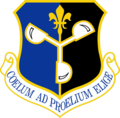|
11th Operational Weather Squadron
The 11th Operational Weather Squadron (11OWS) was an operational weather squadron of the United States Air Force. The squadron was based out of Elmendorf AFB, Alaska, and was responsible for forecasting Alaska's weather and analyzing its climate. The squadron was first activated in early 1941 as the Air Corps Detachment, Weather, Alaska at Ladd Field. It was soon moved to Elmendorf Field (later Air Force Base). The detachment oversaw weather stations in Alaska and after the Attack on Pearl Harbor in February 1942 became the 11th Air Corps Squadron, Weather. The squadron was redesignated the 11th Weather Squadron in 1944. In 1952 the squadron was relocated to Keesler Air Force Base in Mississippi where it inactivated five years later. In 1958 the squadron was reactivated at Elmendorf. The squadron was inactivated after a short stay at Eielson Air Force Base in 1992. The squadron was reactivated as the 11th Operational Weather Squadron at Elmendorf in 1998. HistoryWorld War IIThe 11th Operational Weather Squadron was constituted as Air Corps Detachment, Weather, Alaska, on 15 November 1940, and activated on 11 January 1941 at Ladd Field, Alaska, assigned to the Ninth Service Command. The detachment was commanded by Captain Wilson H. Neal and consisted of a Technical sergeant and five other enlisted men, transferred from March Field. Its mission was to operate the Alaska Weather Region to provide Army Air Corps aircraft and Alaska Army units with weather service. The detachment relocated to Elmendorf Field on 2 May.[2] On 7 December, when the Japanese attacked Pearl Harbor, the detachment oversaw the weather stations at Elmendorf, Ladd, Annette Island, and Yakutat, a total of 44 enlisted men and three officers.[3] The squadron was redesignated the 11th Air Corps Squadron, Weather, on 26 February 1942 and transferred to the 11th Air Force. On 28 May, it activated a weather station at Fort Glenn. In October, the squadron activated a weather station at Adak and its remotest station at St. Matthew Island. Now-Lieutenant Colonel Neal was transferred and replaced by Major Paul A. Carlson in November. A station at Amchitka was activated on 24 January 1943. After the American liberation of Attu in May, the squadron established a weather station at Alexai Point on the island. The Adak and Alexai Point stations provided forecasts for a number of bombing raids against Paramushir in the summer. By the end of 1943, the squadron controlled 32 weather stations, manned by 81 officers, seven NCOs, and 447 enlisted men, its peak strength.[3] On 6 January 1944, the squadron became the 11th Weather Squadron. In February, both weathermen and a radio operator at the Chuginadak station died of exposure while searching for a supply barge which had run aground on the island. During the war, three men of the squadron received the Distinguished Flying Cross, seventeen received the Bronze Star, three were awarded the Army Commendation Medal, and five were awarded the Air Medal.[3] The squadron was transferred to the Army Air Forces Weather Service (later the Air Weather Service) on 22 October 1945.[2] Cold WarOn 4 December 1945, the squadron became part of the 7th Weather Group (later the 2107th Air Weather Group). On 20 April 1952, the squadron was relocated to Keesler Air Force Base in Mississippi, becoming part of the Air Weather Service. A month later it became part of the 8th Weather Group. The squadron was inactivated at Keesler on 18 November 1957. The squadron returned to Elmendorf and was reactivated on 18 June 1958, replacing the 7th Weather Group.[1] On 1 June 1959, the squadron became part of the 4th Weather Wing. It was transferred to the 3rd Weather Wing on 30 June 1972. Between 20 January and 1 February 1989, elements of the squadron participated in Exercise Brim Frost 89, training Joint Task Force-Alaska against invasion.[1] The squadron became part of the 1st Weather Wing on 1 October 1989. It was reassigned to Pacific Air Forces on 30 September 1991, when weather squadrons of Air Weather Service were transferred to the commands they supported. The squadron relocated to Eielson Air Force Base on 1 April 1992, becoming part of the 343d Operations Group on 15 April. The squadron was inactivated on 1 June.[2][4] Operational Weather SquadronThe squadron was redesignated the 11th Operational Weather Squadron on 5 February 1999, and activated on 19 February 1999 with the 611th Air Operations Group.[2] The squadron provided mission tailored, operational, and tactical level meteorological, geological, oceanographic, and space environment products and services for Department of Defense air and land operations in the Alaskan region. They provided headquarters staff support to the Alaskan Command, Eleventh Air Force, PACAF, and U.S. Army Alaska, and contingency support to the Alaska NORAD Region.[5] As a result of USAF manpower and budget reductions, the 11th OWS was inactivated and merged with the 17th Operational Weather Squadron in Hawaii in June 2008. This merger was completed on 13 June 2008.[6] LineageThe lineage of the 11th Operational Squadron from inception to 2008:[4]
AssignmentsThe assignments of the 11th Operational Squadron from inception to 2008:[4]
StationsThe stations of the 11th Operational Squadron from inception to 2008:[4]
Awards and campaigns
ReferencesCitations
Bibliography
External links
|
||||||||||||||||||||||||||||||||||||||||||||||||||||||||||||||||||||||||||||



